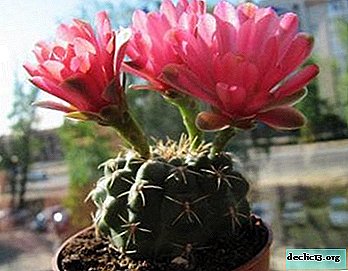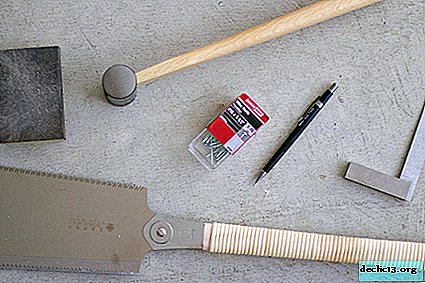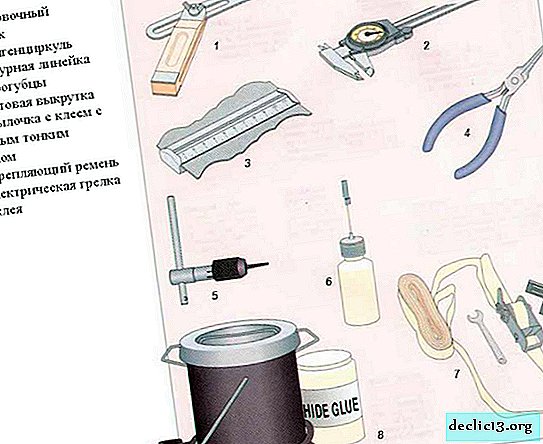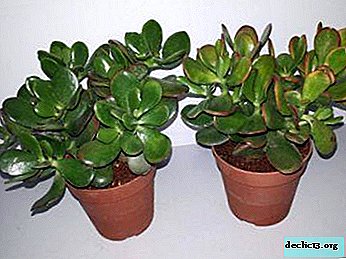Recommendations to gardeners: how, when and how to feed an orchid?

Orchids are exquisite flowers that are great for growing at home. They are distinguished by a variety of varieties and unpretentious care.
But to achieve a long and lush flowering is possible only under the condition of modern fertilizing. Today, there are a sufficient number of drugs that differ in composition and effect.
Next, we consider the best folk methods and specialized fertilizers for the successful growth of your beauty.
How to fertilize a plant - the best means
Folk
It is not necessary to use purchased preparations for feeding orchids, since there is a fairly wide selection of folk remedies:
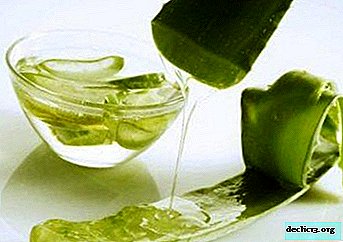 Aloe juice.
Aloe juice.This plant grows in almost any home. To feed the flower, take it in an amount of 1 tsp. and dilute in 1.5 liters of clean water.
- Pomegranate and lemon peel.
For 1 liter of water, take 50 g of crusts, insist 1 day, and then use for root dressing.
- Aspirin.
Take 1 tablet of Aspirin, dilute in 1 liter of water. It turns out an excellent solution for spraying leaves and flowers. It is designed to enhance immunity.
- Sugar.
Once every 30 days, water the orchid with a solution obtained from 1 tsp. sugar and 1 liter of standing water.
- Castor oil.
Take 1 liter of water, add 1 tsp. castor oil. Cover and shake. The oil will begin to break into small fractions, which will mix with water. Immediately after shaking, until the castor has risen, water the flower.
On a note. If the plant blooms once a year, then adding such fertilizing is sufficient once a year. If the flowering is constant, then you can feed with castor oil once a month. - Ash.
This tool perfectly protects against pests and at the same time saturates the flower with potassium, calcium, phosphorus. To prepare the solution, take 1 tbsp. ash in powder form, pour 1 liter of hot water. Insist 7 days, stirring occasionally. Water the solution in the warm season once every 10-12 days, and in the cold - once a month.
Specialized
Pokon
This fertilizer is suitable for prolonging the flowering of orchids. Use it for root dressing. The composition contains the following components:
 nitrogen;
nitrogen;- phosphoric acid;
- potassium oxide;
- boron;
- copper;
- iron;
- manganese;
- molybdenum;
- zinc.
The product is equipped with a dosing cap with a risk, which defines 5 ml and a level scale. According to the instructions, to prepare the solution, Pokon concentrate should be diluted with water in a ratio of 1: 200 (for 5 ml of the product 1 liter of water). Feed every 2 weeks throughout the year. The cost of the drug is 228 rubles.
Japanese blue
 This is a liquid fertilizer that combines nutritional components and bioactive enzymes. With its use, plant growth is activated, the measles system is actively developing. Fertilizer increases the resistance of the flower to diseases and pests.
This is a liquid fertilizer that combines nutritional components and bioactive enzymes. With its use, plant growth is activated, the measles system is actively developing. Fertilizer increases the resistance of the flower to diseases and pests.
The drug is suitable for plant nutrition after transplantation, sudden changes in climate. Before applying this Japanese fertilizer, cut off the tip of the bottle cap. Turn over, set in a flower pot under a slight slope, so that the narrow part is in the ground. The cost of the drug is 155 rubles.
Potassium monophosphate
 It is a chlorine-free and completely water soluble substance. Presented in the form of a white powder. Potassium monophosphate is intended for plant nutrition.
It is a chlorine-free and completely water soluble substance. Presented in the form of a white powder. Potassium monophosphate is intended for plant nutrition.
It is brought with water for watering and for root top dressing in various soil. In its composition, it belongs to one of the most concentrated phosphorus-potash fertilizers. You can buy top dressing at a price of 100 rubles per 1 kg.
Joy
 This product is specifically designed for annual and perennial flowers. Great for orchids. Its action is to extend the duration of flowering, the formation of large inflorescences with a bright color.
This product is specifically designed for annual and perennial flowers. Great for orchids. Its action is to extend the duration of flowering, the formation of large inflorescences with a bright color.
To prepare the solution, take 1 liter of water and 5 ml of the product. Use once every 2 weeks. The cost of the drug is 98 rubles.
Zircon
This the drug is a rooting agent, flowering inducer and immunomodulator. It has a strong anti-stress and fungicidal effect. The drug is not toxic. It has the following indications:
 transfer;
transfer;- soaking cuttings, seeds;
- watering the soil;
- spraying leaves.
To prepare the solution, take 10 liters of water and 1 ml of the product. The cost of the drug is 13 rubles per 1 ml. You can read more about this tool for rooting and better adaptation of the plant in another article.
Liquid remedy Flower happiness
 it complex fertilizer intended for roots and foliar top dressing. It is used to feed all types of orchids. Contains trace elements in chelated form.
it complex fertilizer intended for roots and foliar top dressing. It is used to feed all types of orchids. Contains trace elements in chelated form.
When using the drug, rapid growth and development of the plant is achieved, lush and prolonged flowering, increased resistance to negative environmental factors. To prepare the solution, take 10 liters of water and 1 ml of the product. The cost of the drug is 142 rubles.
Mr color
 These are mineral fertilizers with a general spectrum of action. Suitable for most varieties of orchids. Apply for root dressing. Take one cap and dissolve in 1 liter of water. Watering should be done 2 times a month.
These are mineral fertilizers with a general spectrum of action. Suitable for most varieties of orchids. Apply for root dressing. Take one cap and dissolve in 1 liter of water. Watering should be done 2 times a month.
The vitamins contained in the top dressing contribute to the maximum assimilation of all nutrient components by the plant, and provides a powerful development of the root system. The presence of amino acids enhances the photosynthetic activity of orchids, allows you to overcome developmental delays caused by various factors. The price of the drug is 51 rubles per 0.3 liters.
Agricola
This is a liquid complex fertilizer, which contains mineral salts and humic substances. Also There are a number of additional trace elements:
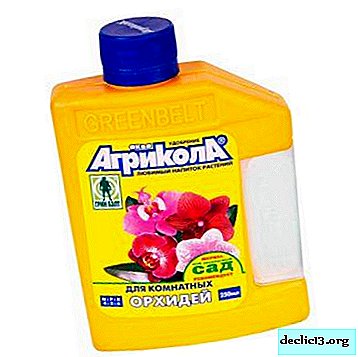 boron;
boron;- copper;
- zinc;
- manganese;
- iron;
- molybdenum.
This the drug is intended for root dressing of different varieties of orchids. The disadvantages of this tool include the lack of an accurate composition. As you know, an excess of trace elements is harmful to orchids. To prepare the solution, take 5 ml of the composition and 1 liter of water.
Reference. Apply it for watering orchids no more than 1 time in 10-14 days.The cost of the drug is 81 rubles.
Fasco
This drug is used for root and foliar dressing of all types of orchids. Used to enhance the growth and development of the flower, when transplanting it on the balcony and in the winter garden.
Using the drug helps to achieve the following effect:
- harmonious growth and development;
- long and lush flowering;
- increased resistance to negative environmental factors.
To prepare the solution, take 5 ml of the product and dilute in 10 l of water. The cost of the drug is 201 rubles.
The method of feeding orchids with finished fertilizers:
When and how often should I feed my homely beauty?
Before applying dressing for an orchid, you need to consider seasonality, condition and soil composition. The following indications for using fertilizer are:
 A permanent microclimate with various fungi and microorganisms, which also process minerals, has formed in the old soil. With frequent application of fertilizers in such soil, minerals will begin to accumulate and grease it, as a result of which the orchid will die. So, the older the plant, the less likely it is to fertilize.
A permanent microclimate with various fungi and microorganisms, which also process minerals, has formed in the old soil. With frequent application of fertilizers in such soil, minerals will begin to accumulate and grease it, as a result of which the orchid will die. So, the older the plant, the less likely it is to fertilize.- If the flower was recently transplanted into a self-prepared substrate treated with boiling water, then the plant should be fed with nitrogen.
- If the soil contains a lot of polystyrene or other synthetics, then fertilize more often.
- How to feed an orchid in autumn and winter is a matter of your personal choice, the most important thing is to remember that in these seasons the plant should be fertilized no more than 1 time per month. At this time, peace comes and the flower grows slowly, therefore, the expenditure of nutrients is carried out in small quantities.
- As soon as spring comes, the plant begins to come to life and accelerates metabolic processes. The absorption of nutrients is much faster, so orchids will need a new dose of nutrition.
In spring, it is necessary to use preparations for leaf and flowering, introducing them 2 times a month. In summer, flower development slows down again, so adding nutrients is enough 1 time per month. About what fertilizers are needed for flowering plants, read here.
All the details about how and how to feed an orchid at home, you will find in this article.
Is it possible to use preparations intended for other colors?
Orchid is not capricious in terms of plant nutrition. Thanks to which it can be fed with formulations intended for other plants. Only in doing so It is important to consider the composition of the drug so that it contains nitrogen, phosphorus and potassium.
Types of feeding
Depending on the consistency, all types of top dressing can be divided as follows.
Concentrated
Concentrated fertilizer (double superphosphate) is a nutrient that is obtained by the decomposition of natural phosphates with phosphoric acid. These compounds can be used for root and foliar top dressing. For maximum effect, it is better to use them in tandem.
In sticks
Such top dressings contain carefully selected nutrients. Fertilizers in sticks for orchids contribute to abundant and prolonged flowering. Use them during the period of flower growth. All tips on what fertilizers a plant needs during flowering can be found in a separate article.
On a note. Before using the sticks, you need to measure the diameter of the pot. The larger the capacity, the more sticks it will need.Stick the sticks fully into the soil, evenly distributing them near the flower. water the ground so that the fertilizer takes effect. Add new sticks every 3 months.
Liquid
 This form of fertilizer is most often used to feed orchids. These are special solutions intended for foliar top dressing. They give the opportunity to get all the nutrients in the flower without the risk of oversaturation. Liquid formulations are classified into groups into the following types:
This form of fertilizer is most often used to feed orchids. These are special solutions intended for foliar top dressing. They give the opportunity to get all the nutrients in the flower without the risk of oversaturation. Liquid formulations are classified into groups into the following types:
- Potash. Thanks to them, you can improve the appearance of the plant, activate its growth and the laying of buds. To better dissolve fertilizers dissolve them in warm water.
- Nitrogen. They affect the growth of green mass. All prepared mineral composition is dissolved in water, but it is better to use ammonium nitrate.
- Phosphoric. They contribute to budding and long flowering. They are poorly soluble in water, with the exception of ammophos.
For those who want to learn more about dressing in more detail, we suggest reading this article, and what nutrients and vitamins are necessary for an orchid, we will tell here.
Which are better and why?
In fact, choosing the most effective fertilizer for orchids is not so simple. each of the presented means is effective in its own way. If we consider folk compositions, then castor oil remains useful for an orchid. Thanks to its use, it is possible not only to prolong flowering, accelerate the development of the flower, but also create reliable protection against diseases and pests.
Of the finished preparations, gardeners are most appreciated Zircon. The peculiarity of the drug in the absence of toxic effects. It effectively solves several problems at once, so you can save on buying drugs separately for foliar and root dressing.
For the nutrition of orchids, there are many drugs. Each of them saturates the plants with a certain composition, contributing to a long and lush flowering, reliable protection against diseases and pests. But with top dressing it is not necessary to frequent and use in high dosage. Otherwise, this can lead to the death of the flower.

 Aloe juice.
Aloe juice. nitrogen;
nitrogen; transfer;
transfer; boron;
boron; A permanent microclimate with various fungi and microorganisms, which also process minerals, has formed in the old soil. With frequent application of fertilizers in such soil, minerals will begin to accumulate and grease it, as a result of which the orchid will die. So, the older the plant, the less likely it is to fertilize.
A permanent microclimate with various fungi and microorganisms, which also process minerals, has formed in the old soil. With frequent application of fertilizers in such soil, minerals will begin to accumulate and grease it, as a result of which the orchid will die. So, the older the plant, the less likely it is to fertilize.



